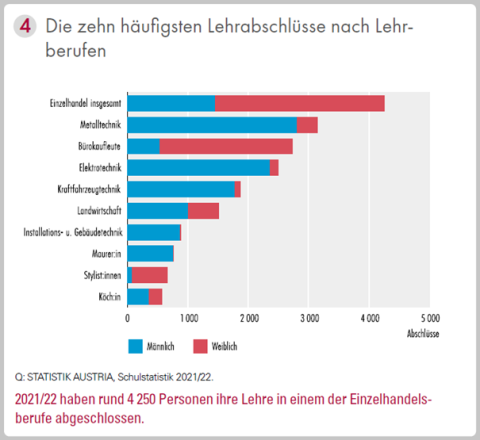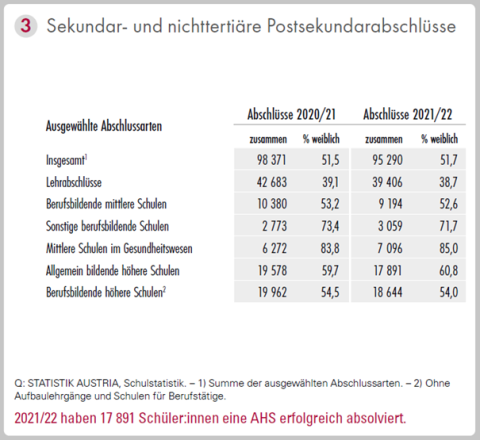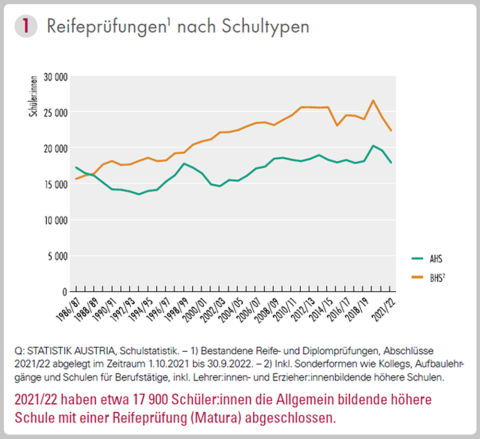Pupil/Students assessment
Students from part-time vocational schools, schools of intermediate vocational education and training (=schools of intermediate VET) and colleges of higher vocational education and training (=colleges of higher VET) are assessed by continually observing their involvement in class and by carrying out written, practical or oral performance appraisals. The lesson repetitions, exams, tests, etc. are prepared and assessed by the class teacher in the respective subject. Relevant regulations are laid down in the ordinance on performance assessments.
The performance appraisals continuously take place over the respective assessment period. The following forms of individual performance appraisals are the most frequent ones:
- determination of the pupils’ involvement in class
- oral performance appraisals (exams and exercises)
- written performance appraisals (homeworks, tests and exams)
- practical performance appraisals
For apprentices, specific regulations apply to in-company training: They are assessed by the person authorised to train apprentices (Lehrlingsausbilder*in). Larger companies with more apprentices even may install training workshops similar to assessment systems at schools and may additionally offer special training programmes for outstanding apprentices or apprentices with support needs. Students at part-time vocational schools, VET schools and colleges receive an end-of-semester and final report every school year.
In the final year of a college of higher VET, a diploma project is prepared during and outside instruction time, with teams working on subject-related topics customised to and appropriate for the specific field of specialisation and profession. In many cases these projects are carried out jointly with or commissioned by enterprises in business and industry. The diploma thesis/work is part and subject matter of the oral matriculation and diploma examination.
Progression of pupils/students
For the progression of the students the provisions of the School Education Act apply (§ 25 ff.).
In part-time vocational school, schools of intermediate VET and colleges of higher VET students are entitled to progress to the next higher grade if their end-of-year report contains assessments in all compulsory subjects, with none of them marked with "fail". However, the class conference may decide by a performance forecast if the individual student is entitled to progress to the next higher grade even with a "fail" in one compulsory subject, unless a "fail" in the same subject in the end-of-year report of the previous school year and if, based on the ongoing performance, she/he can be expected to meet the prerequisites for successful participation in classes and show a positive performance assessment for the class advancement.
Students are also entitled to take a repeat exam at the beginning of the following school year in one or two compulsory subjects.
Certification
After successfully completing their final year, students at part-time vocational school are awarded a final school certificate in their responsibility for apprenticeship specific theoretical instruction, promotion and supplement of the in-company or practical vocational training and general education.
This certificate is the prerequisite for the “practical” apprenticeship leave exam taken by an exam committee made up of one chairperson and two assessors. The successful passing of the exam is confirmed by a final apprenticeship certificate (Lehrabschlusszeugnis) issued by the regional economic chamber (apprenticeship centre - Lehrlingsstelle)
After taking the apprenticeship-leave exam, graduates are classified as skilled workers or journeymen/-women.

Figure: Apprenticeships Certifications 2021 in the 10 most frequent professions in Austria (No English version available.)
Source: Education in Figures in Austria: Key Indicators and Analyses 2022/23 (no English Edition available), S. 41: Download.
A prerequisite for the successful completion of a school of intermediate VET and a college of higher VET is the positive assessment of all compulsory and specialised subjects of the curricula in the final examination.
Exception: As one- and two-year schools of intermediate VET (BMS) only provide preliminary vocational training they are completed without a final exam directly with completion of the final year plus a final certificate. Only BMS with a training period of at least three or four years provide a complete initial VET qualification with a final exam plus certificate.
The final examination at schools of intermediate VET is recognised by the Austrian state and taken by an school exam committee. According to the Vocational Training Act the certificate provides access to professional activities which usually require the apprenticeship-leave exam in a professional and occupational related apprenticeship. The Industrial Code (Gewerbeordnung) regulates the prerequisites for exercising trades on a self-employed basis.

Figure: Secondary non-tertiary examinations according to school types 2020/21 and 2021/22 in Austria (No English version available).
Source: Education in Figures in Austria: Key Indicators and Analyses (2022/23), (no English Edition available), p. 41: Download.
Colleges of higher VET are completed with a final certificate and the matriculation and diploma examination. This certificate has a recognition of the Austrian state and is highly appreciated at the Austrian labour market. At EU level, the high educational level of the BHS is taken into account in the directive on the recognition of professional qualifications, which came into force on 18 January 2014.
The new matriculation and diploma examination was introduced in 2015/16 at colleges of higher VET. Students can choose to take either 3 written and 3 oral or 4 written and 2 oral exams. Similarly to the new matriculation exam at AHS, the tasks of the written general-education subjects are standardised. The maturity exams for all students Austrian wide take place at the same time. The exam questions in German, a modern foreign language and mathematics are occupation- and application-oriented. The oral exam in which the practice-oriented diploma project is presented in front of an exam committee headed by a school supervision officer has not been standardised. The circumstance that the final exam leads to the higher education entrance qualification and professional qualifications coined the term ”double qualification”. With the matriculation, graduates can consequently take up a higher education programme. With the qualification for professions, graduates acquire professional authorisations according to the Industrial Code. This means that after several years of professional practice they are entitled to pursue relevant trades as independent entrepreneurs.
Education and training programmes at Austrian colleges of higher VET can be assigned to the diploma level of the Directive (according to Article 13(2) subparagraph 3 and Annex III). As expressly laid down in the Directive, this diploma provides access to a regulated profession in another member state for which training at the level of higher or university education of (up to) four years’ duration is obligatory.
Graduates of colleges of agriculture and forestry obtain agricultural authorisations according to the Vocational Training Act concerning Agricultural Occupations.
Graduates of (most of the) colleges of engineering and crafts and colleges of agriculture and forestry additionally acquire the right to carry the legally protected professional title "Ingenieur/Ingenieurin" after at least three years of relevant and qualified professional practice and passing a certification procedure (c.f. chapter 6.7).

Figure: Matriculation examinations according to school types 1986/87 to 2021/2022 in Austria (No English version available.)
Source: Education in Figures in Austria: Key Indicators and Analyses (2022/23), (no English Edition available), p. 41: Download.
.
.

